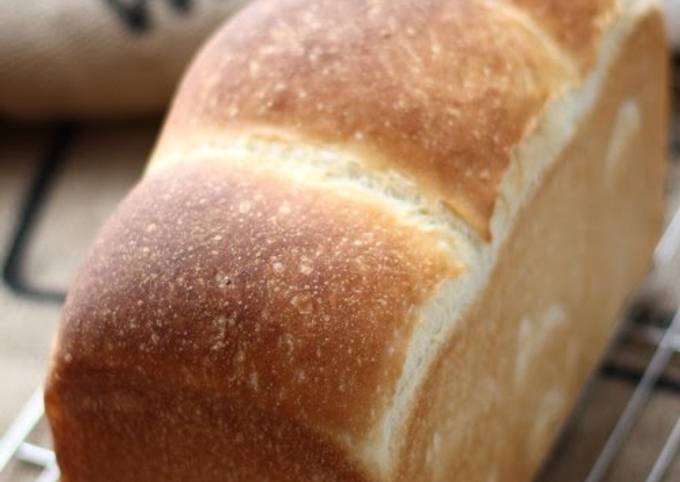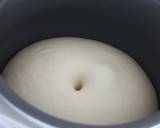Recipe: Perfect An Everyday Shokupan Square Loaf Bread
An Everyday Shokupan Square Loaf Bread. If you want a loaf with a rounded top, let it rise until it's risen a bit higher than the rim. Shoku Pan is a Japanese square loaf bread that is often eaten as toast or used for sandwiches. Although rice is the biggest staple food in Japan, Shoku Pan bread today may be the most popular breakfast item.
 Once the first rising has finished, remove the dough from the bread maker. The most ubiquitous type of bread in Japan is the white and pillowy square-shaped bread called shokupan, which simply means "eating bread." Made of white flour, yeast, milk or milk powder, butter, salt and sugar, shokupan is both loved and taken for granted by most. Place the shaped dough, seam side down, in a greased loaf pan. You can cook An Everyday Shokupan Square Loaf Bread using 9 ingredients and 13 steps. Here is how you achieve that.
Once the first rising has finished, remove the dough from the bread maker. The most ubiquitous type of bread in Japan is the white and pillowy square-shaped bread called shokupan, which simply means "eating bread." Made of white flour, yeast, milk or milk powder, butter, salt and sugar, shokupan is both loved and taken for granted by most. Place the shaped dough, seam side down, in a greased loaf pan. You can cook An Everyday Shokupan Square Loaf Bread using 9 ingredients and 13 steps. Here is how you achieve that.
Ingredients of An Everyday Shokupan Square Loaf Bread
- It's 255 grams of Bread (strong) flour.
- Prepare 25 grams of Cake flour.
- You need 20 grams of Skim milk powder.
- You need 33 grams of White castor or superfine sugar.
- Prepare 5 grams of Salt.
- It's 5 grams of Dry yeast.
- You need 250 ml of Water.
- Prepare 10 grams of Unsalted butter.
- Prepare 10 grams of Vegetable oil.
Repeat with the other dough balls, placing them in the center, and near the other end of the pan. Japanese Milk Bread (Shokupan) Be the first to rate & review! This pillowy soft, subtly sweet sandwich bread is a beloved breakfast staple in Japan and is typically eaten sliced very thick, lightly toasted, and served with accompaniments like butter and jam. Remove from the pan immediately and cool on a wire rack.
An Everyday Shokupan Square Loaf Bread step by step
- Put all the ingredients in a bread machine and knead until the gluten develops. I took it out of the machine once the kneading was done and rounded off the dough before the 1st rising. Check with a finger to see if it has risen enough (a hole made floured finger should not bounce back)..

- Take the dough out and deflate. Divide into 2 to 3 portions, and round off each piece so that the surface is taut and smooth and pinch the seams closed. Cover with plastic wrap and rest for 10 minutes..
- When the dough has rested, deflate it again and roll out about 20 to 25 cm square. Fold into thirds lengthwise, roll up from the near side, and pinch the rolled end closed..
- Put the dough pieces in an oiled bread pan. Cover with plastic wrap and use your oven's bread-rising setting to let the dough rise for 40 to 50 minutes at 30-40°C (2nd rising)..
- If you want a square loaf let the dough rest to about 80% of the height of the pan. If you want a loaf with a rounded top, let it rise until it's risen a bit higher than the rim..
- Preheat the oven to 180°C. When the oven has heated up, bake the bread for 30 minutes at 180°C and it's done. If it looks like the top is browning too fast, cover with a piece of foil..
- As soon as it comes out of the oven, drop the bread pan and all from about a 30 cm height to push out the steam. Take the loaf out of the pan..
- Dense and bouncy and yet light and fluffy. The result is a bread with a lasting moist, tender texture!.
- This one is baked in a square shokupan pan. I turned this into sandwiches for an outing. Since the bread stays moist and soft, it was great even after some time had passed..
- This is a version with bacon and melting type cheese rolled into the dough..
- .
- The version in the top photo was made with my own homemade started. I used 150 g of starter and 220 ml of water..
- When the bread has cooled down completely, I slice it into pieces and keep it in bags. It's moist and soft the next day..
I use Japanese brand Nisshin flour. Place dough, top-side down, on lightly floured work surface to deflate. Fold bottom edge two thirds of the way up, and fold again so that the top edge meets the bottom edge as you would a business letter. Shokupan means "eating bread" in Japanese and it is also commonly referred to simply as Japanese white bread. It is quite similar to Hokkaido Milk Loaf but is less sweet and eggless.
Comments
Post a Comment